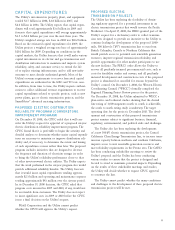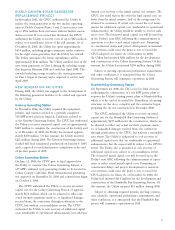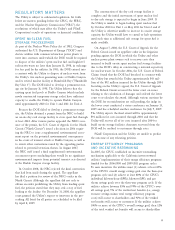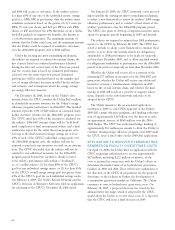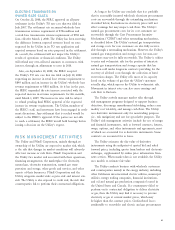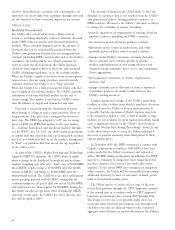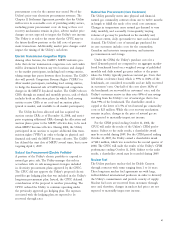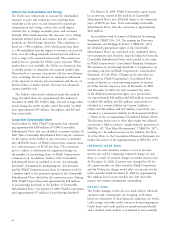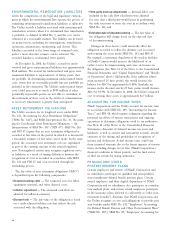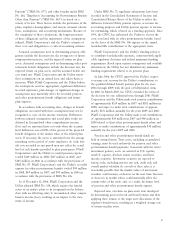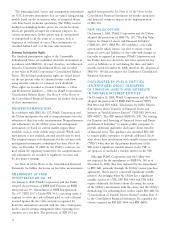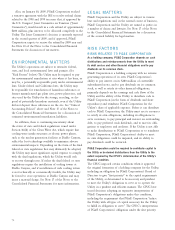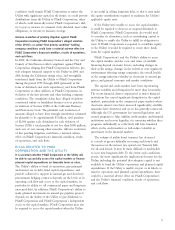PG&E 2008 Annual Report Download - page 65
Download and view the complete annual report
Please find page 65 of the 2008 PG&E annual report below. You can navigate through the pages in the report by either clicking on the pages listed below, or by using the keyword search tool below to find specific information within the annual report.63
Natural Gas Procurement (Core Customers)
The Utility generally enters into physical and fi nancial
natural gas commodity contracts from one to twelve months
in length to fulfi ll the needs of its retail core customers.
Changes in temperature cause natural gas demand to vary
daily, monthly, and seasonally. Consequently, varying
volumes of gas may be purchased in the monthly and,
to a lesser extent, daily spot market to meet such seasonal
demand. The Utility’s cost of natural gas purchased for
its core customers includes costs for the commodity,
Canadian and interstate transportation, and intrastate
gas transmission and storage.
Under the CPIM, the Utility’s purchase costs for a
fi xed 12-month period are compared to an aggregate market-
based benchmark based on a weighted average of published
monthly and daily natural gas price indices at the points
where the Utility typically purchases natural gas. Costs that
fall within a tolerance band, which is 99% to 102% of the
benchmark, are considered reasonable and are fully recovered
in customers’ rates. One-half of the costs above 102% of
the benchmark are recoverable in customers’ rates, and the
Utility’s customers receive in their rates 80% of any savings
resulting from the Utility’s cost of natural gas that is less
than 99% of the benchmark. The shareholder award is
capped at the lower of 1.5% of total natural gas commodity
costs or $25 million. While this cost recovery mechanism
remains in place, changes in the price of natural gas are
not expected to materially impact net income.
For the CPIM period ending October 31, 2008, the
CPUC will audit the results of the Utility’s CPIM perfor-
mance. Subject to the audit results, a shareholder award
may be recorded during 2009. For the CPIM period ending
October 31, 2007, the Utility earned a shareholder award
of $10.1 million, which was recorded in the second quarter of
2008. The CPUC will audit the results of the Utility’s CPIM
performance ending October 31, 2008. Subject to the audit
results, a shareholder award may be recorded during 2009.
Nuclear Fuel
The Utility purchases nuclear fuel for Diablo Canyon
through contracts with terms ranging from 1 to 16 years.
These long-term nuclear fuel agreements are with large,
well-established international producers in order to diversify
the Utility’s commitments and provide security of supply.
Nuclear fuel costs are recovered from customers through
rates and, therefore, changes in nuclear fuel prices are not
expected to materially impact net income.
procurement costs for the current year exceed 5% of the
Utility’s prior year electricity procurement revenues. The
Chapter 11 Settlement Agreement provides that the Utility
will recover its reasonable costs of providing utility service,
including power procurement costs. As long as these cost
recovery mechanisms remain in place, adverse market price
changes are not expected to impact the Utility’s net income.
The Utility is at risk to the extent that the CPUC may in
the future disallow portions or the full costs of procure-
ment transactions. Additionally, market price changes could
impact the timing of the Utility’s cash fl ows.
Electric Transmission Congestion Rights
Among other features, the CAISO’s MRTU initiative pro-
vides that electric transmission congestion costs and credits
will be determined between any two locations and charged
to the market participants, including load serving entities,
taking energy that passes between those locations. The CAISO
also will provide Congestion Revenue Rights (“CRRs”) to
allow market participants, including load serving entities,
to hedge the fi nancial risk of CAISO-imposed congestion
charges in the MRTU day-ahead market. The CAISO releases
CRRs through an annual and monthly process, each of which
includes both an allocation phase (in which load serving
entities receive CRRs at no cost) and an auction phase
(priced at market, and available to all market participants).
The Utility has been allocated and has acquired via
auction certain CRRs as of December 31, 2008, and antici-
pates acquiring additional CRRs through the allocation and
auction phases prior to the MRTU effective date, to be used
when MRTU becomes effective. During 2008, the Utility
participated in an auction to acquire additional fi rm trans-
mission rights (“FTRs”) in order to hedge its physical and
fi nancial risk until the MRTU becomes effective. The CAISO
has delayed the start date of MRTU several times, but is now
targeting April 1, 2009.
Natural Gas Procurement (Electric Portfolio)
A portion of the Utility’s electric portfolio is exposed to
natural gas price risk. The Utility manages this risk in
accordance with its risk management strategies included
in electricity procurement plans approved by the CPUC.
The CPUC did not approve the Utility’s proposed electric
portfolio gas hedging plan that was included in the Utility’s
long-term procurement plan. Instead, the CPUC deferred
consideration of the proposal to another proceeding. The
CPUC ordered the Utility to continue operating under
the previously approved gas hedging plan. The expenses
associated with the hedging plan are expected to be
recovered through rates.




